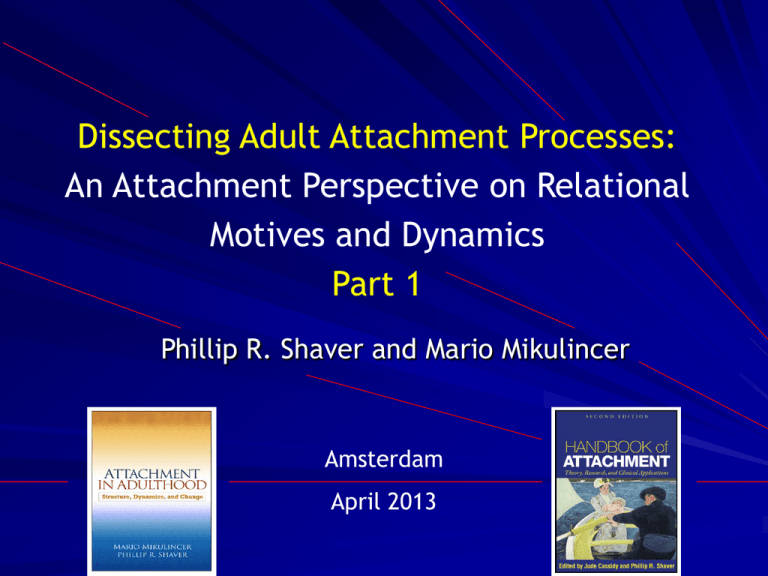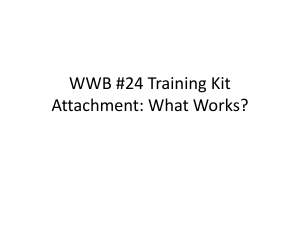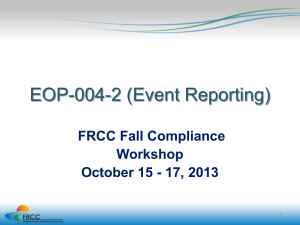
Dissecting Adult Attachment Processes:
An Attachment Perspective on Relational
Motives and Dynamics
Part 1
Phillip R. Shaver and Mario Mikulincer
Amsterdam
April 2013
Overview
Goal: To convey some of what we have learned while
pursuing an adult extension of Bowlby and Ainsworth’s
attachment theory and related infant-mother research
Brief background: attachment theory and its extension — by
social/personality psychologists — into the domain of
adolescent and adult relationships
Our model of attachment-system functioning in adolescence
and adulthood
Sample research on working models in dreams and other
narratives, attachment-system activation, ambivalence,
emotion regulation in behavior and the brain, and
‘caregiving’ in couple relationships
Bowlby’s
attachment theory
Created by John Bowlby, a British psychoanalyst,
based partly on primate ethology, to explain why
“maternal deprivation” so often leads to later
anxiety, anger, delinquency, and depression
He published five
major books about
the theory between
1969 and 1988,
including one on
psychotherapy
Ainsworth’s contribution,
a great gift to Bowlby
Bowlby’s theory was first tested on infants and
their mothers by Mary Ainsworth, an American
psychologist, and her colleagues (whose major
book appeared in 1978)
She invented a laboratory procedure,
the Strange Situation, to assess the
quality of an infant’s attachment to
mother. Classifications based on this
measure have been shown, in 30-year
longitudinal studies, to predict ― in
conjunction with later experiences ―
mental health and relationship quality
Harlow’s monkeys and Ainsworth’s
“Strange Situation”
Secure attachment
facilitates exploration;
insecure attachment
interferes with it
Attachment theory
distilled
Humans, especially infants, rely on attachment figures for
protection, support, and help with emotion regulation
The attachment behavioral system is an evolved, innate
regulator of proximity (hence of safety and safe exploration)
When threats abate, behavioral systems other than
attachment (e.g., exploration, caregiving) can be activated,
allowing a person to become more competent/autonomous
Attachment orientations, or “styles,” develop in
relationships, resulting in systematic individual differences in
attachment orientation: secure, anxious, avoidant, . . .
The theory applies from “the cradle to the grave” (Bowlby)
A 1000-page
summary of
basic and
applied
attachment
theory and
research,
published in
2008
Adult attachment ‘styles’ in social/personality
psychology: Regions in a two-dimensional space
HIGH AVOIDANCE
DISMISSING AVOIDANT
FEARFUL AVOIDANT
LOW ANXIETY
HIGH ANXIETY
SECURE
PREOCCUPIED
LOW AVOIDANCE
Adapted from Ainsworth et al. (1978), Bartholomew
& Horowitz (1991), Fraley & Shaver (2000)
Self-report attachment measure
(Brennan, Clark, & Shaver, 1998)
Avoidance (18 items, > .90)
1. I prefer not to show a partner how I feel deep down.
2. I try to avoid getting too close to my partner.
3. I feel comfortable depending on relationship partners. (reversescored)
4. I turn to a relationship partner for many things, including
comfort and reassurance. (reverse-scored)
Anxiety (18 items, > .90)
1. I don’t often worry about being rejected or abandoned.
(reverse-scored)
2. I need a lot of reassurance that I am loved by a partner.
3. I get frustrated if a relationship partner is not available when
needed.
4. I resent it when a partner spends time away from me.
Since Hazan & Shaver (1987) . . .
Hundreds of studies
using self-report
attachment measures
have been conducted
The findings can be
summarized in a
three-part model
(Mikulincer & Shaver,
2007, and elsewhere)
+
-
Signs of
threat?
Activation of
other behavioral
systems
No
Yes
Attachment-system activation
+
Is attachment figure
available?
-
Yes
No
Insecurity, distress compounding
Is proximity
seeking a viable
option?
Yes
Hyperactivating strategies
No
attachment
security,
distress
alleviation
Securitybased
strategies
Deactivating strategies
Aspects of the theory to be considered in
this first of today’s two-part presentation
Mental representations of self and others
(Bowlby’s “internal working models”)
Attachment system activation in the lab
Attachment insecurities and emotion regulation
Ambivalence
Attachment, caregiving, and sex in couple
relationships
First Issue
Attachment Insecurities and Mental
Representations of Self and Others
(in Dreams and Attachment-Related
Mental Scripts)
Attachment insecurities and dreams
(Mikulincer, Shaver, & Avihou-Kanza, A&HD, 2011)
Participants were asked to recall dreams each morning for
30 days and write a brief account of each one, yielding 14
dreams apiece, on average
Two ‘blind’ independent judges used Luborsky’s Core
Conflictual Relationship Themes coding system to
characterize how dreamers represented self and others.
Dreams reported by individuals high in attachment anxiety
included more representations of self as anxious, weak,
and helpless, and more portrayals of others as unloving.
Avoidant attachment was associated with representations
of self as less responsive (more distant, uncooperative,
unexpressive, and angry) toward cold or hostile others.
Sample secure dream
Reported by a young woman who scored low on both the anxiety and
avoidance scales of the ECR, and whom regard as secure:
I was sitting in my elementary school library reading a book, which
seemed very natural even though I haven’t been there for years. I spoke
with friends and teachers, and the place was just as it used to be. The
principal came in and started yelling at us, saying we were barbaric
children. At first I thought we might have been noisy and deserved this
rebuke, but I told him that, despite whatever bad behavior we engaged
in, we didn’t deserve such treatment and he had overlooked my many
good qualities. I felt that despite being a little girl, I had enough selfesteem to tell him he was wrong. So I got up and told him I was not a
barbarian and I came to the library to read books that I like. He then
apologized. I felt proud of myself. At that instant, my mom appeared,
hugged me, and said I was okay and she was also proud of me. (I don’t
know how my mom got there.) She then took me to some fun place; I
don’t know where. I just remember that we laughed a lot and bought
some silly things – maybe in a mall.
Sample anxious dream
Reported by a young man who scored high on attachment anxiety:
I’m arguing with friends about who teaches a particular course. I start
running toward the city and see a bank robbery in progress. Suddenly I
realize that I am the bank robber! I’m debating with myself about
whether I should break into the bank or not, and I decide that I should. I
get into the bank and yell, “Give me the money!” The teller stoops
down below the counter, gets the money, and hands it to me, and I run
away. While exiting the bank, I shoot three times in the air and then run
down the street with the weapon wrapped in a quilt. While running, I
suddenly think about what I’ve done and what a bad person I am:
“Maybe I hit someone while shooting in the air.” I’m debating with
myself about where to run and suddenly notice that the money has
disappeared. I think, “Why can’t I do something right for once?” I want
to cry. Suddenly the cops arrive. I say, “Take me. Maybe it’s for the
best that I go to jail. No one cares about me anyhow.” I feel really
ashamed of what I did. Suddenly my dad appears and yells at me: “How
dare you do such a foolish thing! You deserve to go to jail. You’re
worthless.” It hurts, but I know that what he says is true.
Sample avoidant dream
Reported by a young woman who scored high on avoidant attachment:
My parents wanted me to go with them to my grandma’s house, and a
discussion ensued about whether it was worth going and if she would or
wouldn’t have food for us. I said I didn’t want to go, and I went into the
backyard alone. There was a “cat party” going on, and many disgusting,
filthy black cats were sitting in a circle, facing out, with their backs
toward each other. Every cat screamed, one at a time, and if the cat
opposite to that one correctly identified the screamer, that cat won. I sat
in the corner with my computer and was afraid to move. I thought, “Why
didn’t they run away when they saw me?” I realized that because there
were so many of them, they knew they had power over me and could
easily wipe me out. Suddenly, my computer fell and landed close to the
cats. I had to save it, so I got closer to them, but when I did, they jumped
on the computer and threatened me with aggressive expressions and
horrible screams. They started to sing, “If you don’t go home, you’ll have
to tell us who is a nice cat.” I had to answer with a song saying that all of
them were nice. They then let me have my computer. I wanted to destroy
them one by one, but instead I went inside with the computer . . . and
woke up in terror.
Knowledge of the “secure-base script”
(Mikulincer, Shaver, et al., JPSP, 2009)
Harriet Waters showed that attachment security,
measured in children, is related to implicit
understanding of what she calls the secure-base
script: “If I’m threatened or distressed, I can turn to
an attachment figure for help, I will be comforted,
and I can then return safely to other matters.”
Empirical findings
(Mikulincer, Shaver, et al., JPSP, 2009)
We conducted multiple studies in which people
were asked, for example, to describe what was
happening in a series of drawings that form an
outline of the beginning of the secure-base script.
(Similar to a TAT.)
In Study 1, the richness, or completeness, of
people’s responses were predicted by the ECR
anxiety and avoidance dimensions: ß = -.35 for
anxiety and ß = -.45 for avoidance (and this was
not due to narrative length or verbal ability).
More on the “secure-base script”
In Study 2, participants saw only the first picture from the
previous series of four, showing a person in distress, and they
wrote about what would happen next.
Insecure (anxious and/or avoidant) participants were less likely to
include all parts of the secure-base script. But the two kinds of
insecurity were associated with different gaps in the script.
Anxious people’s stories tended to lack the final step (relief and
return to other activities), whereas avoidant people’s stories
tended to lack the part about actively seeking others’ support).
That is, anxious people more often wrote about an injured
protagonist who was seeking support and not achieving relief,
whereas avoidant participants more often wrote about a person
achieving relief without seeking or receiving support. (The results
were not due to neuroticism, extraversion, or verbal ability.)
Further studies of insecure scripts
(Ein-Dor, Mikulincer, & Shaver, JPSP, 2011)
In five studies we identified two kinds of scripts that insecure
people use in response to threats:
– A sentinel script, characteristic of anxious individuals,
who focus intently on possible threats, detect them
quickly, and immediately communicate about them to
others (which can sometimes be useful to others, but is
often viewed as an annoyance)
– A rapid fight-flight script, characteristic of avoidant
individuals, who rapidly find a way to deal with a threat
by attacking the problem or fleeing (which can also
benefit others, even though the response is usually not
altruistic in intent)
The social benefits of these scripts is discussed in a theoretical
paper (Ein-Dor, Mikulincer, Doron, & Shaver, PoPS, 2010).
Second Issue:
Attachment-System Activation
(in the Lab)
The attachment system
can be unconsciously activated
(Mikulincer et al., JPSP, 2000)
Subliminal (22 millisecond) priming with a threat word
(e.g., failure, illness, death) heightens mental
accessibility of attachment-related concepts –- e.g.,
faster responses to attachment-related words (e.g., love,
hug, secure, close) in a lexical decision task
Secure people activate positive but not negative
attachment concepts; anxious people activate both
positive and negative concepts; avoidant people activate
both, but activate the negative ones only when a
“cognitive load” is added
This suggests that anxiety and avoidance are (as
theorized) rooted in earlier painful experiences with
attachment figures, and that avoidance requires effortful
suppression or repression
(Sample fixation point,
shows for 500 milliseconds)
X
X
(subliminal, invisible prime word,
shown for 22 ms and then masked)
death
(visible target word)
love
(stays visible until the person presses a
key indicating it is either a word or not a
word: e.g., evlo)
More about attachment-system activation
Subliminal priming with a threat word (e.g., failure,
separation) increases accessibility of attachment figures’
names but not names of other familiar people
(Mikulincer, Gillath, & Shaver, JPSP, 2002).
Attachment anxiety correlates with faster access to
attachment figures’ names regardless of threat (perhaps
an example of anxious vigilance)
Avoidant attachment correlates with slower access to
attachment figures’ names (suppression) when the threat
word is “separation,” but not “failure” (so the
suppression may be somewhat attachment-specific)
We have obtained similar results among religious people
for “God” and God-related concepts (e.g., a Torah
scroll), suggesting that God can serve as an attachment
figure (Granqvist, Mikulincer, & Shaver, PSPR, 2010;
JPSP, 2012)
An interesting attachment-formation study (Beckes et
al., 2010, Psych. Science), using some of our methods
• They presented subliminal pictures of a striking snake, a mutilated
body, or a neutral stimulus
• Followed by a supraliminal picture of a
smiling woman’s face or a control face
• Measured reaction times in a lexical decision task to securityrelated words (safe, kind, protect, secure, trust, warm) and
insecurity-related words (alone, anxiety, threat, distress, rejection,
despair, needy) in the presence of the pictured face.
• Found an interaction: The secure words were perceived faster and
the insecure words slower in the presence of the smiling face if it
had been paired unconsciously with the frightening stimuli.
Third Issue:
Emotion Regulation
Avoidant attachment and
emotion regulation
Avoidant individuals inhibit or block
emotional states that are incongruent with
the goal of keeping their attachment
system deactivated
Avoidant inhibition and suppression require
mental effort, and hence can be overridden by cognitive load and stress
Two examples . . .
Color-naming times (in msec) for separation
words during a Stroop task
700
675
650
625
600
High Load - Low
Avoid
Low Load - High
Avoid
Low Load - Low
Avoid
High Load - High
Avoid
575
Control
Suppression
Avoidant people showed no “rebound” of separationrelated thoughts when not under a high cognitive load,
but they couldn’t avoid the rebound under a high load
(Mikulincer, Dolev, & Shaver, JPSP, 2004)
Broader summary of findings regarding
suppression of thoughts of loss/rejection
Under low load conditions, avoidant people are able
to suppress thoughts of loss and defensively activate
positive self-representations
Under high load, they can’t suppress thoughts of loss
or negative self-representations, suggesting (as in
other studies) that their defensive strategies require
constant effort
Not emphasized here but true: Anxious people in our
studies seem unable to suppress thoughts of loss or
negative self-traits
A real-world example: Mothers with a CHD child
(Berant, Mikulincer, & Shaver, 2008)
Participants: 63 mothers of children diagnosed with
CHD during their first months of life; they underwent
three waves of data collection (immediately following
diagnosis, a year later, and 7 years later)
Measures: A physician’s rating of CHD severity at T1;
ECR-like attachment scales given to the mother at T1,
an overall maternal mental health scale given at T’s 1, 2,
and 3; a marital quality scale given at T’s 1, 2, and 3; a
child-appropriate explicit self-concept measure and the
CAT (projective story measure) given to the child at T3
(when he/she was 7 or 8 years old)
A few results
Mother’s avoidance at T1 and the interaction of her
avoidance with the child’s CHD severity predicted a
decline over time in her marital quality and mental
health. Non-avoidant mothers showed no such
deterioration, regardless of child’s CHD severity.
Mother’s avoidance and anxiety at T1 predicted
child’s poorer explicit self-concept at age 7-8. Also,
the child’s “dominant affect” (in the CAT) was more
negative at age 7-8 if the mother had been more
avoidant 7 years earlier.
In general, the stress of having a child with severe
CHD was too much for more avoidant mothers to
handle, perhaps because avoidant coping collapsed
under a high “coping load.”
Attachment anxiety and
intensification of emotion
As mentioned, anxious individuals seem
unable (or unwilling?) to suppress negative
emotions
To learn more about their intense
emotionality, we used neuroimaging (fMRI)
Regions in which attachment anxiety correlates
.74**/.64** with activation during thoughts of loss
(Gillath et al., NeuroImage, 2005)
L
Left anterior temporal pole
associated with recall of sad
thoughts (Lévesque et al., 2003)
activation during negative thoughts
(Think Negative > Think Neutral) was
correlated with attachment anxiety
(r = .74**)
Left hippocampus
associated with memory retrieval (Eichenbaum, 2004)
activation during negative thoughts was correlated
with attachment anxiety (r = .64**)
cf. behavioral studies by Mikulincer & Orbach (1995)
R
Suppressing negative thoughts:
Negative correlation with attachment anxiety
L
R
L
R
Don’t Think > Think (contrast values)
Activation in orbitofrontal cortex (OFC; BA 11)
Attachment Anxiety
Associated with emotional control (e.g., Shimamura & Knight, 2002)
Thus, anxious people have, or exert, less emotional control than
non-anxious people when explicitly asked to exert control
Fourth Issue:
Attachment Insecurity and
Relational Ambivalence
Experimental studies of ambivalence
(Mikulincer, Shaver, Bar-On, & Ein-Dor, JPSP, 2010)
“Ambivalence” was one of the terms Ainsworth
used to characterize anxious attachment to
mother in infancy: “anxious-ambivalence.”
In the Strange Situation, infants classified as
anxiously attached to mother were ambivalent
during reunions, approaching and clinging at one
moment, angrily arching their backs and refusing
to be calmed the next. They wanted closeness
but also resisted it.
We wanted to see whether we could measure
relational ambivalence in laboratory studies of
college-aged adults.
Study 1 – Aims and rationale
In Study 1, we asked whether high scorers on the
ECR measure of anxious attachment exhibit
simultaneous activation of approach and
avoidance tendencies, and at both explicit and
implicit levels.
Both measures are important because high scores
on explicit measures wouldn’t necessarily
indicate that approach and avoidance tendencies
coexisted in a person’s unconscious goal
structure.
Study 1 - Method
110 university students (81 women, 29 men)
currently involved in a romantic relationship
completed the ECR measure of attachment
anxiety and avoidance.
Explicit (conscious) relational ambivalence was
assessed with the Ambivalence in Intimate
Relationships scale (Thompson & Holmes, 1996).
In the AIR, participants were asked to describe
their positive and negative feelings toward six
traits of their romantic partner (e.g., his/her
emotional closeness, relationship commitment).
Study 1 - Method
Implicit relational ambivalence was assessed
with an approach-avoidance task developed
by Chen and Bargh (1999).
Participants were exposed to positive and
negative words related to closeness and distance
from relationship partners, as well as positive and
negative non-attachment words.
Study 1 - Method
On each trial, they were asked either to pull a
joystick (a lever) back toward themselves
(approach/closeness response) or to push the lever
away from themselves (avoidance response) when
they recognized a word, and latencies for initiating
these responses were recorded.
We defined ambivalence as the co-existence of
approach and avoidance tendencies to the same
stimulus. We computed three scores for each
participant by averaging ambivalence scores for (a)
attachment-irrelevant words, (b) closeness words,
and (c) distance words.
Study 1 - Results
β Anxiety
β Avoidance
Explicit ambivalence
.49**
-.06
Implicit ambivalence
toward closeness words
.28**
.01
Implicit ambivalence
toward distance words
.24*
.11
Measure
Notes: * p < .05; ** p < .01
Study 2 – Aims and rationale
In Study 2, we hypothesized that attachmentanxious people’s ambivalence would be intensified
by both (a) signs of a partner’s interest/liking and
(b) signs of a partner’s rejection.
That is, attachment-anxious people would react to
a partner’s expression of interest not only with
approach tendencies but also with fear of rejection
(causing avoidance as well as approach).
They would also react to a partner’s expressions of
rejection not only with self-protective avoidance
tendencies but also with desperate wishes for
affection and security (i.e., approach tendencies).
Study 2 – Method
90 Israeli students (54 women and 36 men)
completed the ECR scale and interacted with an
opposite-sex confederate and were randomly
divided into three conditions:
–
(a) Liking (the confederate expressed interest in
working together with the participant).
–
(b) Rejection (the confederate expressed a preference
for working alone rather than with the participant).
–
(c) Control (the confederate did not signal liking or
rejection).
Participants then completed the approachavoidance task used in Study 1, assessing implicit
ambivalence toward closeness and distance words.
Study 2 – Results
Effects
Attachment anxiety
Attachment avoidance
Partner’s liking
Partner’s rejection
Anxiety x liking
Avoidance x liking
Anxiety x rejection
Avoidance x rejection
Notes: * p < .05; ** p < .01
β Ambivalence toward
closeness words
.32*
-.14
.16
-.10
.27*
.01
.26*
-.07
Study 2 - Results
The link between attachment anxiety and
implicit ambivalence toward closeness words was
significant in the liking and the rejection
condition, but not in the control condition.
Additional analyses revealed that being liked or
rejected by the confederate created greater
ambivalence toward closeness words when
attachment anxiety was relatively high, but not
when it was relatively low
Study 2 – Results
Effects
Attachment anxiety
Attachment avoidance
Partner’s liking
Partner’s rejection
Anxiety x liking
Avoidance x liking
Anxiety x rejection
Avoidance x rejection
Notes: * p < .05; ** p < .01
β Ambivalence toward
distance words
.20*
.11
.12
.11
.17
-.01
.19
.34*
Study 2 - Results
Attachment anxiety was slightly associated with
implicit ambivalence toward distance words.
Avoidant attachment was associated with implicit
ambivalence toward distance words only in the
rejection condition.
That is, the experience of a potential relationship
partner’s rejection caused the more avoidant
participants to react to distance words with
greater implicit ambivalence (reminiscent of our
earlier finding for the word “separation” in the
lexical decision study).
Fifth Issue:
Couple Relationships
Romantic love (couple pair-bonding) can be
conceptualized as the integration of 3 behavioral
systems discussed by Bowlby: attachment,
caregiving, and sex
Attachment
Pair
bonding
Hazan and Shaver
(1987)
Attachment and sex
Many studies have shown that attachment anxiety and
avoidance are related to sexual motives, fantasies, and
behavior (e.g., Schachner & Shaver, 2004)
Anxious people tend to use sex, sometimes without due
caution, to get a partner’s attention, feel more loved,
and bind their partner into the relationship
Avoidant people tend to begin sex later but then become
more promiscuous than anxious and secure people in
adulthood; they tend to use sex to boost self-esteem and
reputation among peers, but not to feel psychologically
intimate with their partner (more “one-night stands”)
Both kinds of insecure people have shorter relationships
than secure people, on average
A survey study of sexuality
We (Brassard, Shaver, & Lussier, 2007) surveyed a
representative sample of 273 French-Canadian
heterosexual couples aged 18–35.
Avoidant attachment was significantly related to
two strategies for limiting sexual intimacy:
avoidance of sexual encounters and avoidance of
sexual fantasies about the partner (women only).
Anxious attachment appeared to interfere with
comfortable intimacy, especially among men, who
viewed their partner as avoiding sex and applied
more pressure to have sex.
Attachment and sexuality in couples
seeking marital therapy
A large clinical sample of 242 French-Canadian
couples seeking marital therapy completed the
ECR and the Index of Sexual Satisfaction (Brassard,
Péloquin, Dupuy, Wright, & Shaver, 2012).
Results showed that both attachment anxiety and
avoidance predicted individuals’ own sexual
dissatisfaction (actor effects).
We also observed 2 partner effects: (a) anxiety in
men predicted female partners’ sexual
dissatisfaction and (b) avoidance in women
predicted male partners’ sexual dissatisfaction.
A daily diary study of sexual fantasies
(Birnbaum, Mikulincer, & Gillath, PSPB, 2011)
Young Israeli couples kept daily diaries concerning
sexual fantasies and described aspects of their
relationship functioning for 21 days.
Avoidant attachment was related to sexual
fantasies that emphasized non-intimacy, control
of sexual interactions, and negative views of
fantasy sexual partners.
Anxious attachment was related to sexual
fantasies that emphasized desires for closeness,
perception of the self as weak and dependent, and
perception of fantasy sexual partners as cruel and
abusive.
Attachment and caregiving
Many studies have shown that attachment anxiety and
avoidance are related to deficits in caring for relationship
partners and engaging in altruistic behavior more
generally (e.g., Kunce & Shaver, 1994; Gillath et al.,
2005).
Anxious people tend to be self-focused when engaged in
supposedly caring/altruistic actions, leading to
intrusiveness, poor assessment of others’ actual needs,
and personal distress.
Avoidant people tend to be less interested in helping
others and to derogate needy others. They are relatively
deficient in the domain of compassion and love.
A current project: Overcoming ‘mental
depletion’ when offering support to a partner
(studied in Israel and in Davis: Mikulincer, Shaver,
Sahdra, & Bar-On, A&HD, in press)
Both members of college-student couples (involved for at
least 6 months) were invited to complete questionnaire
measures on a website and participate in a lab experiment.
Each partner independently entered a website from home or
work and completed measures, including the Experiences in
Close Relationship Scales (attachment anxiety and avoidance)
Each partner provided names of people (other than their
partner) who were their security providers (using the WHOTO
Scale), as well as the names of unfamiliar people (from a list
we provided)
Methods
Couples came to the lab and were informed that they
would be videotaped during an interaction in which one of
them (whom we view as “the care-seeker”) disclosed a
personal problem to the other (“the caregiver”).
After the instructions, one experimenter took the
“caregiver” to another room where security priming and
cognitive depletion manipulations were applied.
The second experimenter remained with the “care-seeker”
and asked him or her to think and write about any
bothersome personal problem that he or she could discuss
(except one that involved conflict with the partner).
Methods (continued)
Caregivers performed a Stroop color-naming task
during which they were randomly assigned to one of
two priming conditions:
– Security Priming: Subliminal exposure (for 20
milliseconds on each trial) to names of security
providers nominated in the WHOTO questionnaire
(not including the romantic partner).
– Neutral Priming: Subliminal exposure to names
of unfamiliar persons.
Methods (continued)
Half of the caregivers in each priming condition
were asked to state aloud the color of a word as it
appeared on the computer screen (e.g., the word
GREEN printed in blue). This procedure is known to
create cognitive depletion (mental fatigue).
The other half of the caregivers were asked to state
aloud the color of a word which also named the
color, which did not require overriding automatic
responses and hence did not result in depletion.
Methods (continued)
Following these manipulations, couple members
were reunited and videotaped while they talked (for
10 minutes) about the problem the care-seeker
wished to discuss.
Two independent judges, blind to questionnaire
measures and experimental conditions provided the
following ratings:
– Caregivers’ responsiveness (listening, understanding,
supporting, soothing)
– Caregivers’ dismissing/withdrawal behavior
– Caregivers’ criticism
Results
There were significant main effects of priming and
cognitive depletion: Security priming increased
responsiveness, and cognitive depletion reduced it.
There was also, as predicted, a significant primingby-depletion interaction, such that security priming
erased the negative effects of depletion.
The main effects and the priming-by-depletion
interaction were significant in both the American
and Israeli samples.
The following slides show the interaction.
Means of caregiver’s responsiveness in the total sample,
broken down by priming and depletion conditions
5.5
5
4.5
Depletion
Control
4
3.5
3
Security
Priming
Neutral Priming
F(1, 205) = 6.09, p < .01
Means of caregiver’s responsiveness in the American
sample according to priming and depletion conditions
5
4.5
4
Depletion
Control
3.5
3
Security
Priming
Neutral Priming
F(1, 127) = 3.93, p < .05
Means of caregiver’s responsiveness in the Israeli
sample according to priming and depletion conditions
6
5.5
5
4.5
Depletion
Control
4
3.5
3
Security
Priming
Neutral Priming
F(1, 127) = 4.21, p < .05
Findings for Dispositional Measures
The higher a caregiver’s anxious or avoidant attachment,
the lower his or her responsiveness to a partner’s
disclosure. And the higher a caregiver’s self-control or
self-esteem, the higher his or her responsiveness.
The same results were obtained in both countries.
Conclusion: Security priming, even in a lab setting, can
overcome a barrier to responsive support of a partner
who is disclosing a distressing problem, but this doesn’t
erase individual differences.
Looking ahead to Mario’s talk: It contains many more
applied/clinical studies.
End of Part 1 . . .
Questions?
A full publication list can be acquired by emailing Shaver at
prshaver@ucdavis.edu or Mikulincer at mario@idc.ac.il
Thank You !
Dank je wel !






